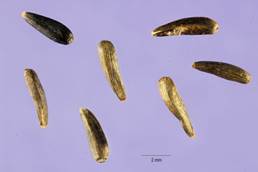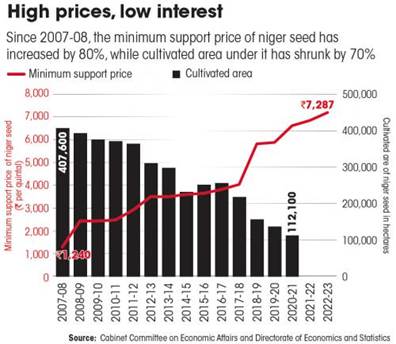
Disclaimer: Copyright infringement not intended.
Context
- India’s Niger seed cultivation is declining.
Niger
- Niger is a minor oilseed crop that is grown predominantly under rainfed conditions.
- Native to Ethiopia, Eritrea and Malawi, niger seeds are also grown in India.
- Niger seeds resemble sunflower seeds in shape, but are smaller in size and black.
- It bears a fairly thick, adherent seed coat and can be stored for up to a year without deterioration. Niger seed contains proteins, oil and soluble sugars.
- Commercial Niger seed is grown in Africa, India and other areas of southeast Asia, and the seed is imported around the world as a popular type of birdseed.
Cultivation
- Requiring moderate rainfall between 1,000 to 1,250 millimetres annually, niger seed needs moist soil to grow properly.
- Niger should be grown in light black soils or brownish loam with sufficient depth but it also can be grown on well drained heavy soils or rocky laterite soils.
- The crop can grow on denuded soil and its cultivation method is fairly basic: After the first rain when the soil is moist, farmers need to plough the field and sprinkle the seeds.
- The crop neither requires much water nor fertilisers and pesticides.
- Niger seed is a local food crop that is grown 100 per cent naturally in the country.
Areas of cultivation
- In India, niger is grown on an area of 2.61 lakh ha mainly during kharif. However, in Odisha it is a rabi crop.
- Andhra Pradesh, Assam, Chattisgarh, Gujarat, Jharkhand, Karnataka, Madhya Pradesh, Maharashtra, Odisha and West Bengal are the states where Niger is grown. The average yield in India is 3.21 q / ha.
Niger Seed and Oil
- Niger seed yields about 30–35% of its weight in oil which is clear, slow-drying, and edible.
- Niger seed oil is polyunsaturated semi-drying oil. It has a pale yellow or orange color with a nutty taste and sweet odor. The raw oil has a low acidity and can be used directly for cooking.
- Normally, it has a poor shelf life and will become rancid when stored for a long period. It is used as a substitute for olive oil and can be mixed with linseed oil.
Culinary and medicinal uses
- Niger seeds are used for human consumption in the southern parts of India.
- In Karnataka, Andhra Pradesh and Maharashtra, niger seeds are used to make a dry chutney. They are also used as a spice in some curries.
- In Ethiopia, an infusion made from roasted and ground niger seeds, sugar and water is used in treating common colds.
- The Indian tribal population uses niger seed oil for cooking, the press cake post oil-extraction as livestock feed, and also consume the seeds as a condiment. Niger seed oil has medicinal properties, which is the reason for its commercial demand by the cosmetics, perfumeries and other allied industries.
Niger a Kharif MSP Crop
- One of the 14 kharif crops for which the Centre releases a minimum support price (MSP) every year is an unlikely plant called niger or ramtil (Guizotia abyssinica). Niger commands one of the highest MSPs, fixed on the basis of the cost of production and market demand.
- The primary reason such a sparsely grown crop is part of the exclusive MSP list is because niger seed has traditionally been the lifeline of tribal agriculture and economy in several states across India.

Decline in cultivation
- The area under its cultivation has been steadily shrinking over the past three decades. In 1985-86, niger was cultivated on around 0.6 million hectares (ha), according to a 2013 report by the All India Coordinated Research Project on Sesame and Niger (AICRP), Jabalpur.
- In 2020-21, the cultivated area shrunk by 80 per cent to a little over 0.1 million ha, the lowest among the 14 kharif crops with MSP.

Reasons behind decline in cultivation
Parasite
- Niger plants are regularly destroyed by amarbel, a twining parasitic plant known as Cuscuta chinensis. Depending on the amarbel density, niger seed yield decreases by 52 to 99.2 per cent. Hence, Tribal families are growing paddy instead of niger.
Seeds from private growers
- The reason for the gradual increase in amarbel infestation lies in the fact that most farmers informally procure seeds from private growers or fellow farmers.
- Such seeds aid in the spread of amarbel weeds as the “identity, genetic purity, quality and source of the seed is not authenticated.
Lack of access
- Government research institutes have developed high-yielding, amarbel-resistant niger varieties, but these seldom reach farmers.
- The agriculture department has recently developed the JNS 28 and 30 varieties of niger that are resistant to amarbel. But the quantity is so low that there is nothing to give to the farmers.
Poor quality seed production
- The existing formal system of seed production had been hardly sufficient to cope with the seed requirement.
- Minor crops like niger are not high-priority in seed producing agencies and therefore the production of quality seed for the farmers of this crop is pathetic.
No priority to Tribal food
- Niger is falling out of favour among its only patrons because tribal food has not been a priority for the government.
Government apathy
- The government apathy means that most initiatives to support niger farmers seldom reach them.
- Many farmers in Madhya Pradesh and Chattisgrah are not aware of MSP for the crop and customarily sell their produce to local traders at a price lower than the government support price.
In a nutshell, Lack of government interest in tribal cuisine, amarbel infestation, low productivity of niger seeds and increasing paddy cultivation are some of the factors responsible.
Limited choice of High Yielding Varieties, use of farm saved seed with low seed replacement rate and low input application are the major factors contributing to low yield in Niger.
Way Ahead
- Need of the hour: Setting up of seed villages for producing high-quality niger seeds and selling those directly to farmers through agriculture fairs and local shops.
- There is also a ready international demand for niger seed which remains largely unmet. If the government agencies ramp up seed production and provide market access to the tribal communities, niger seed will once again become an economically and environmentally viable source of income for them, particularly those living in arid and hilly areas.
Must read - MSP: https://www.iasgyan.in/daily-current-affairs/minimum-support-price-msp-19
https://www.downtoearth.org.in/news/agriculture/illusive-oilseed-india-s-niger-seed-cultivation-is-declining-here-is-why-84380





